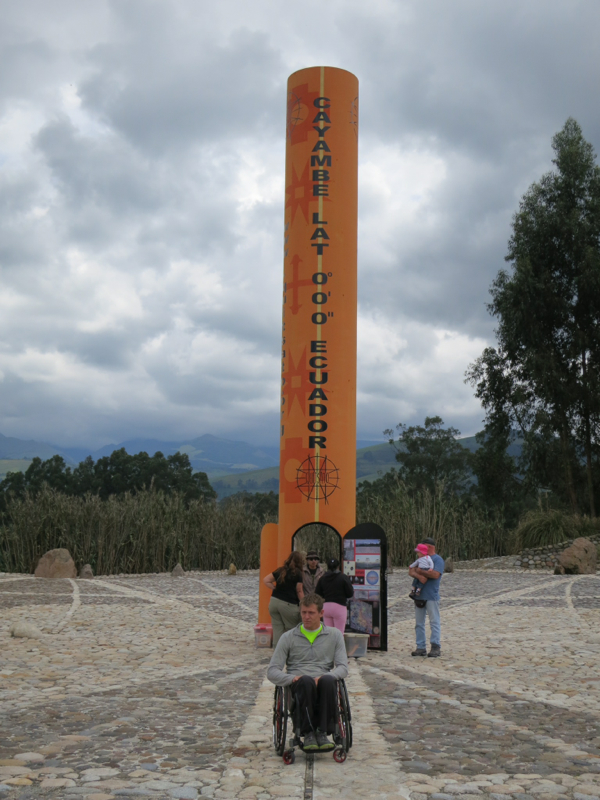
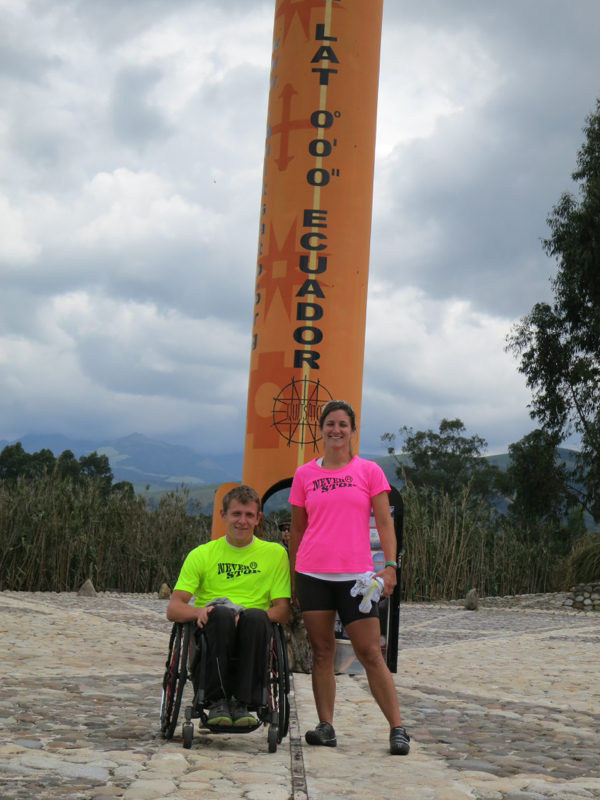
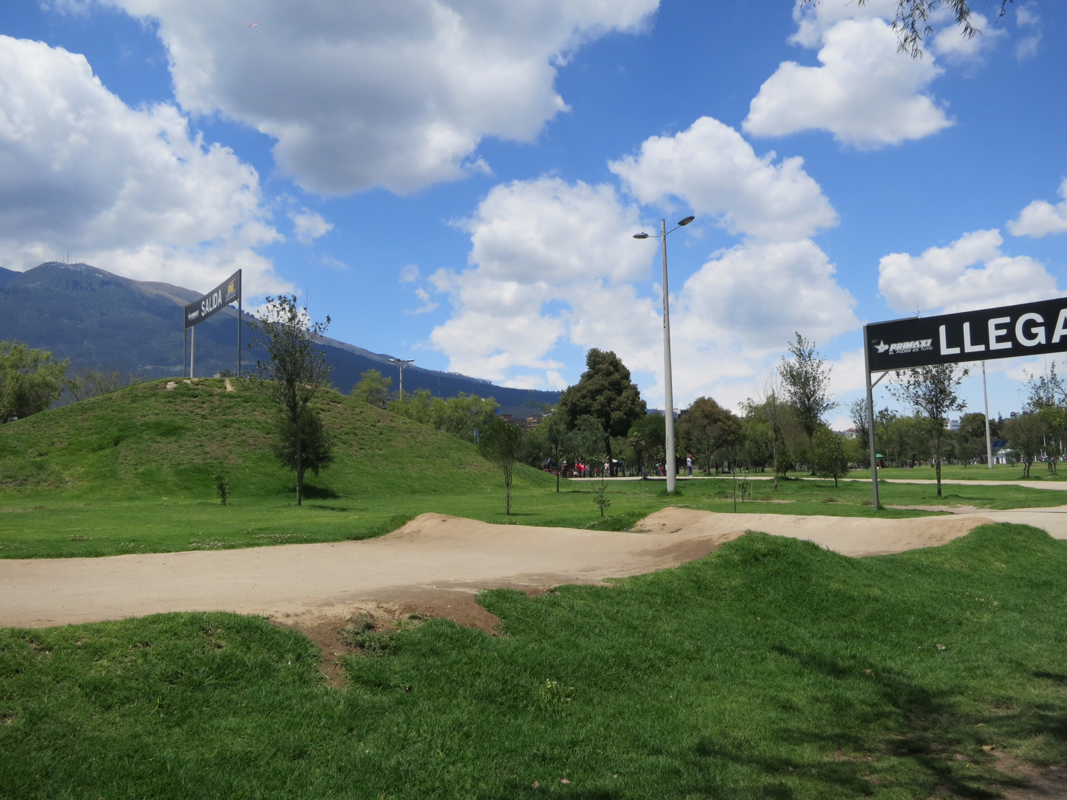
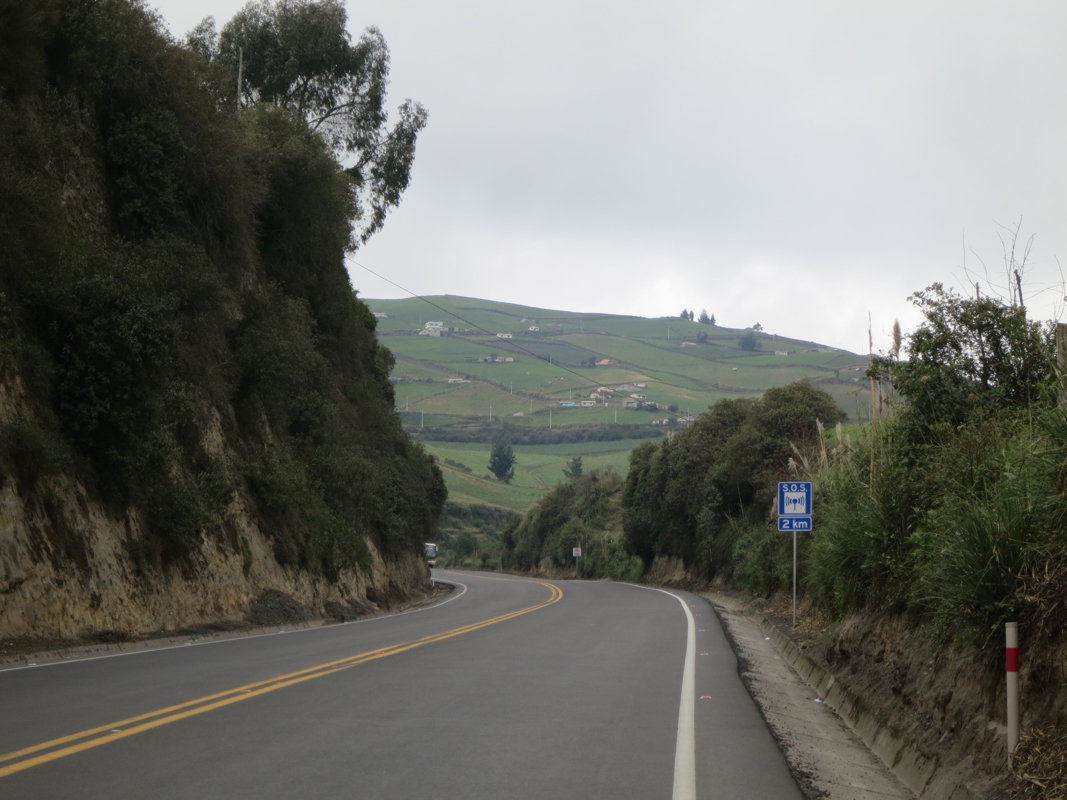
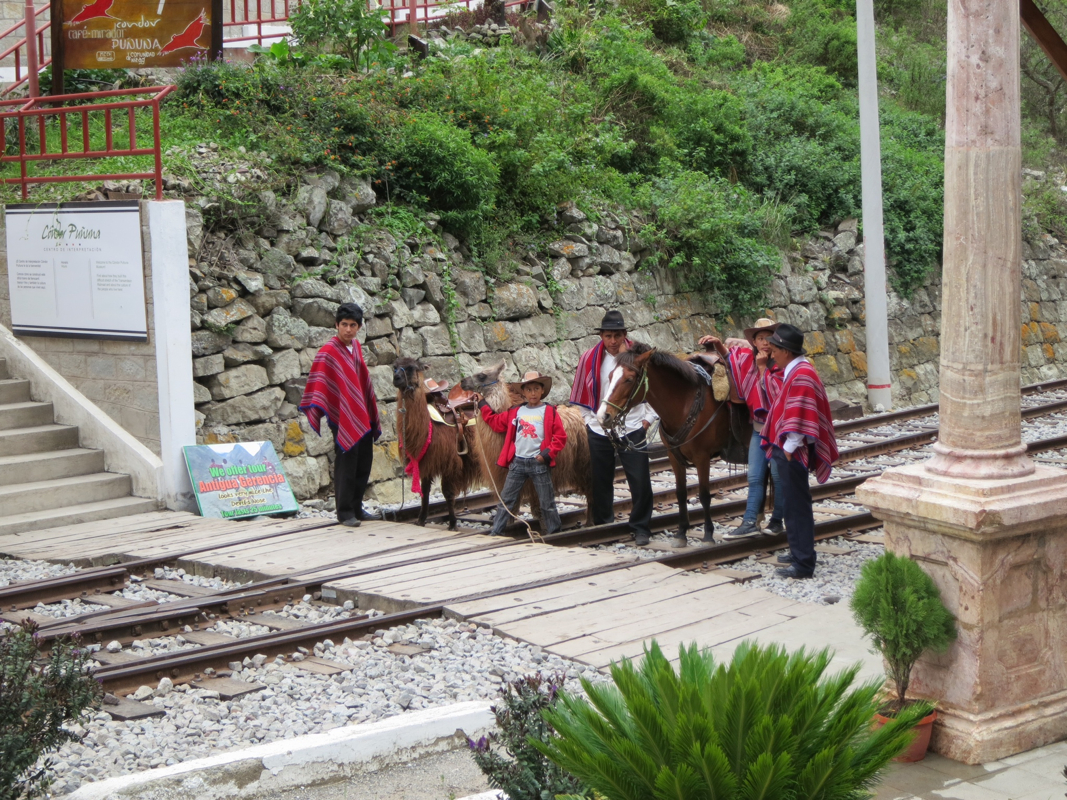

We're going to start this post off right, with the most fantastically fantastic photo of the trip so far. Photographic evidence that the equator is rather anti-climatic in person, and that, in Ecuador specifically, and Latin America generally, there are many, many women in tight pants, that maybe shouldn't be wearing tight pants.

This equatorial monument was pretty mellow and unimpressive, but did have the benefit of actually being on the equator, unlike tourist extravaganza "Mitad del Mundo (middle of the world)" north of Quito. There the "equator" sits about 30 yards off the actually line because of an inconveniently steep hill. Oh, and this monument was home to an organization devoted to all kinds of "equatorial research," though they weren't so good at explaining what said research actually consisted of. I was hoping to at least see some very scientific toilet flushing.

Huge dirt BMX track in the park just across from the apartment we rented in Quito. Awesome. Had me reliving all my youthful dirt bike fantasies engendered by watching "Rad" every time I could get my hands on it at Valley Video. For those of you who haven't seen "Rad," do yourself a favor and Netflix it, a high-point of 80's culture and features Bart Conner in all his toe-headed glory.

Climbing up towards Mt. Chimborazo, the highest mountain in Ecuador, topping out above 20,000ft. The PanAm runs up to about 12,000ft. I realized how silly the terrain is here the night before, when Kelly was talking to her mom and asked me how far we had to climb the next day. "Oh, not to bad...only a little more than 2,000ft" I replied, then though back to the start of our trip, when an impending 2,000ft climb would produce shivers of nervous excitement for a week beforehand. Now it's just another day.

Some of the locals offering themselves, llama, and donkey for photos for $1. They were giving pretty nasty looks to everyone who didn't want to pay. I probably wouldn't be a very happy camper either if my job was to exihibit my cultural heritage as a prop for tourist photos. Hooray for the globalized economy!
3 Comments
There are several ways to describe occupational therapy, particularly because we, as occupational therapists, can address impairments in such a wide array of environments or situations. Our profession is difficult to describe well in a succinct manner. However, this is a decent sentence to help clear things up a bit: Occupational therapy is about helping people do the day-to-day tasks that “occupy” their time, sustain themselves, and enable them to contribute to the wider community. Each day-to-day task, or activity of daily living (ADLs), can either be broken into tiny segments or evaluated from a more broad spectrum. One of the ways to evaluate one's day is through his/her routines. If you think about your day, think about how many routines, big or small, you complete daily. Something as finite as wetting your toothbrush before you start to brush, or something as broad as waking up, coffee, then shower, then breakfast, then work, etc.... With our blog and Facebook posts, we have spoken to very broad manners. With another guest appearance by yours truly, I decided to play my role as an OT and evaluate our daily routine and share it with you. A typical day on the road, camping. Things obviously change from a hotel. Depending on forecasted high temperature, the alarm sounds between 4:30-5:30am (the hotter the climate, the earlier the alarm). Seth is not a morning person. I am. However, I really like lazy mornings drinking coffee. None of this has changed much since leaving the comforts of home. We have realized we need about 2 hours from the time we actually climb out of bed until we are rolling down the road. I get dressed first, my clothes laying on the tent floor next to the sleeping bag for easy access. Pack up my pillow and the compartmental bags of clothes (thank you, Blank Brand) into my pannier that's sitting in the vestibule next to my tent door. Grab all of the small things that attach to my bike that are too valuable to leave on due to theft or rain -- light, the GoPro, and items from my handlebar bag like my wallet and phone. Pack up the electronics, the Nook, iPad and headlamps. Pack up the journals that go into my Camelbak bag. Set all of these separate bags next to the door so that when I get out of the tent, I can easily reach inside and move them outside. Seth has yet to start his day at this point. He's awake, but not moving. It's too difficult for the both of us to move around too much at the same time. I climb out of the tent, in the process evaluate the saturation of the rain fly (lately, it's absolutely soaked with rain or dew)... I grab the bags I've just packed and start to pull apart our bikes, unlock them and open the trailer bag to remove the standing water from the top. While I start to organize our stuff outside the tent, Seth is getting dressed and packing up the remainder of stuff in the tent -- included the sleeping bag and folding up the sleeping pads. I advise him on the layers of clothing needed in the outside temperatures. Then I unpack the stove and get water boiling for coffee. We try to move constantly. There is always something to be done. While the water is boiling, I remove other small bags from the trailer bag so that I can repack it properly (sleeping bag and tent have to go in the bottom or the puzzle just doesn't work). Seth's wheelchair fits under his side of the vestibule but it blocks him in. I unzip his side of the tent, allowing him freedom to get out and continue with the morning. By this time, the coffee is typically ready. I have a titanium cup and he drinks from a Kleen Kanteen bottle. This is the only time we stop. If possible, I sit down with my coffee. We typically take a moment to enjoy the scenery, typically mountains waking up amongst the clouds with us. Once the coffee is gone, though, it's back to work. Clean the pot, pack the stove and have bags lined up along the trailer to organize them before packing them up for the day. Seth is disassembling the tent and I start making breakfast. Breakfast is usually a white bread product with peanut butter. I fill up Camelbak bladders and bottles with water I've hauled from the day before. Put all the panniers back on my bike, load up the trailer bag. Seth gets on his bike and we take off in the southern direction, hopefully before the sun has poked its head up over the mountains. 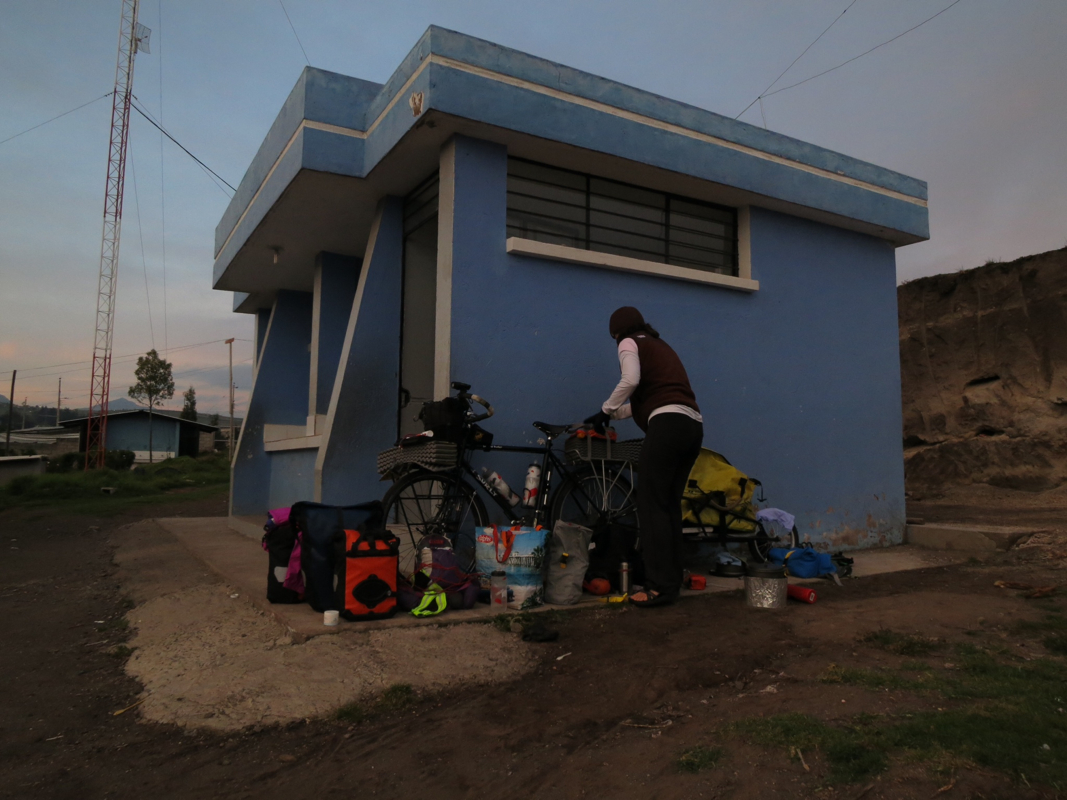
Loading up all the shit that goes onto my bike, one thing at a time. It's gotten into quite a routine at this point and I know exactly where everything goes. It still looks chaotic at this point in the morning, but soon it will be all piled onto one vessel, rolling (hopefully smoothy) down the road.
We try to ride for about an hour before having our first stop with consumption of more simple sugars. If the riding is easy and we lose track of time, it's 2 hours before our first stop. Seth will eat some orange slices, I prefer a Gu or gel product. If possible, we've stopped at a place that I can pee in the bushes. And we continue. We try to stop at least every hour for a bite to eat...sometimes more or less frequently depending on the road quality. We have a mid morning snack, typically consisting of a granola bar. Through Ecuador, we've been drinking iced tea or coke as well. As we ride, we stop to buy items where ever convenient or necessary. The tea and coke purchase is typically in the morning so we can sip throughout the day. Around 1-1:30 we have lunch. Depending on our supplies, it's a repeat of breakfast, but sometimes it's that same white bread product with cheese. Sometimes fruit, too. And coffee. We typically make enough coffee in the morning to make a 'road coffee' - filling the kleen kanteen for the day. I clean up and we continue. If the afternoon grows long, we stop for another sugar snack -- orange slices and gu. But we try to plan our lunches so that it will carry us to the end of the riding day. Since we don't know what the towns will be like, what they will have or how frequent they will be, we stop at gas stations or stores when we can. Seth will typically take advantage of the toilet at a gas station since camping toilets are non-existent and squatting is not a possibility for him. We will get snacks for the afternoon -- chips, nuts, more fresh bread, but most importantly WATER. Because of the weight of water, we try to save this purchase for as late as possible. But I will carry it all day if needed. Depending on the terrain and the long term goals, we start looking for a decent camp site in early afternoon. Things we consider: the next day's terrain -- are we coming close to a HUGE climb that we can't finish today, so lets get as close as possible and hit it hard in the morning?; are we meeting someone soon and have to make so much mileage in a day to get there?; do we feel awesome and just want to keep going?; do we feel like shit and just need to call it a day?; don't want to pass up this perfect campsite?; we need supplies, so we HAVE to keep going?; etc -- there are several things to consider. After 5 months on the road, this is getting easier.... If the day goes as we hope, it's about 3:30 when we find a camping site, look for a person to ask permission, and start evaluating the ground. Where do we put the bikes? My bike is far too heavy to stand on it's own. It does best with a wall or something solid for stability. If no wall, Seth's bike will do. Where do we put the tent? Flat land, away from water, shelter from wind, shelter from the road and any potential people who are going to want to talk to us all night and the next morning. Where can I go pee?! My bladder is about to burst!! Set up the bikes, Seth gets out of his and we start setting up the tent. If there is someone who wants to riddle us with questions, Seth entertains while I set up the tent. Before I put on the rainfly, I put down the sleeping pads and sleeping bags, then throw in the electronics, my Camelbak bag, get out a headlamp. Then put on the rain fly. I put our clothing panniers under the vestibule. Then I jump in the tent, clean off as best as I can with baby wipes and change out of my riding clothes, leaving them next to the sleeping bag in preparation for the next morning. Seth is probably still talking to whomever. If there is a dog, I'm attending to him/her and beginning to get out snacks to replenish our system before dinner. It gets dark around 6:30 and it's nice to be in the tent by then. So we cook dinner and eat around 5 or so -- typically as many calories, grams of carbs and protein we can pack into one pot. We eat a lot of rice, pasta, eggs, tuna, peanut butter and bread. Not really exciting, but it does the trick. We clean up with as little water as possible since we are usually using drinking water. I put everything back into the trailer bag but not packed completely since I'll be getting the stove and pots out for coffee in the morning. I pack up everything water tight for any potential rain and lock up the bikes. We pee and brush our teeth. Seth jumps into the tent first so I can put away his wheelchair. Then I get into the tent. We read and write in our journals. Darkness falls and if it's quiet, we are fast asleep with no problem.....hopefully through the night for about 10 hours. The ideal campsite consists of what is so easily found in the US: level ground with decent shelter. But most luxurious of all -- running water and a toilet. But given the rarity of these, we are continually finding ways around whatever obstacles come our way....like spending a day in the tent in the middle of no where when we were both exploding in both directions. Luckily we make a pretty good team. We are opposite in almost every sense of the word. We see things differently and are able to use each other's opinion to make the best of most situations. 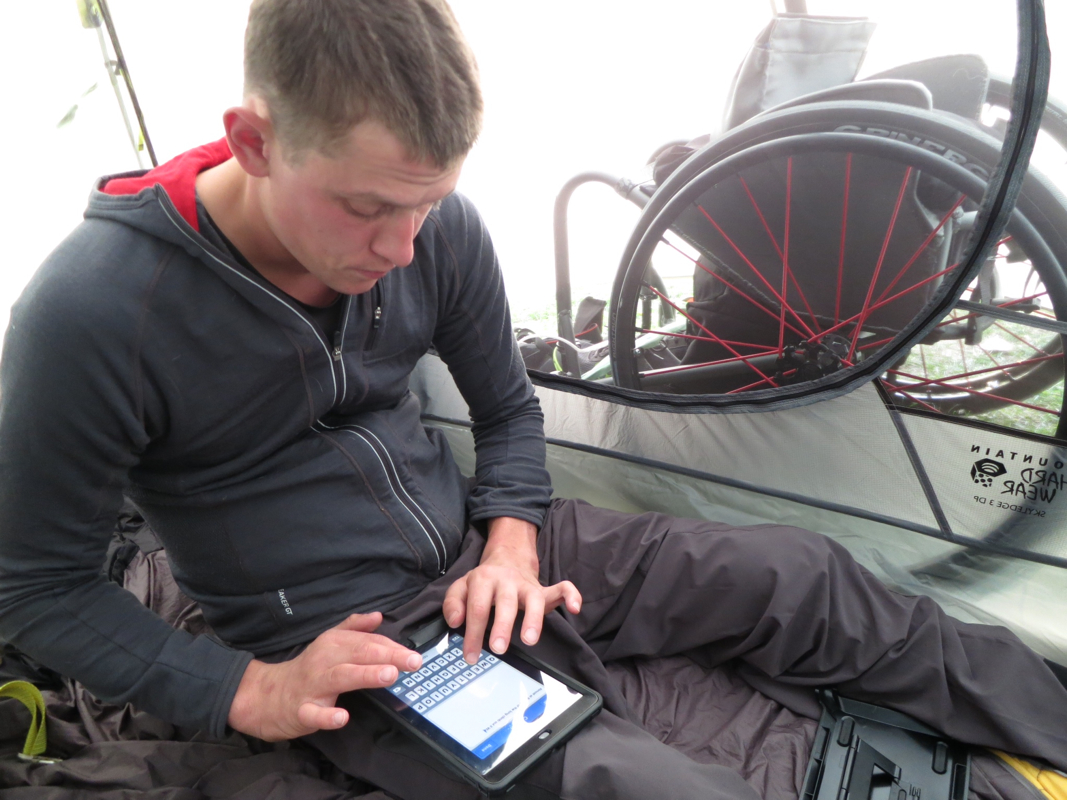
Seth writing and updating the blog from a campsite in Oregon...when we didn't have to rely on fast internet to do anything with our website. In this shot, you can notice how Seth's chair fits under the vestibule and how it blocks him into the tent. It's a good system, though, keeping the chair safe from weather.
If I were to go through our routine from a hotel, it would be pretty similar -- we plug in and recharge our electronics and take a shower!! A shower both in the evening and in the morning. We have learned to never pass up a good cleaning -- especially if there is hot water. Now we're really talking luxury! And in case you were wondering, Seth and I like a wet toothbrush before we brush. 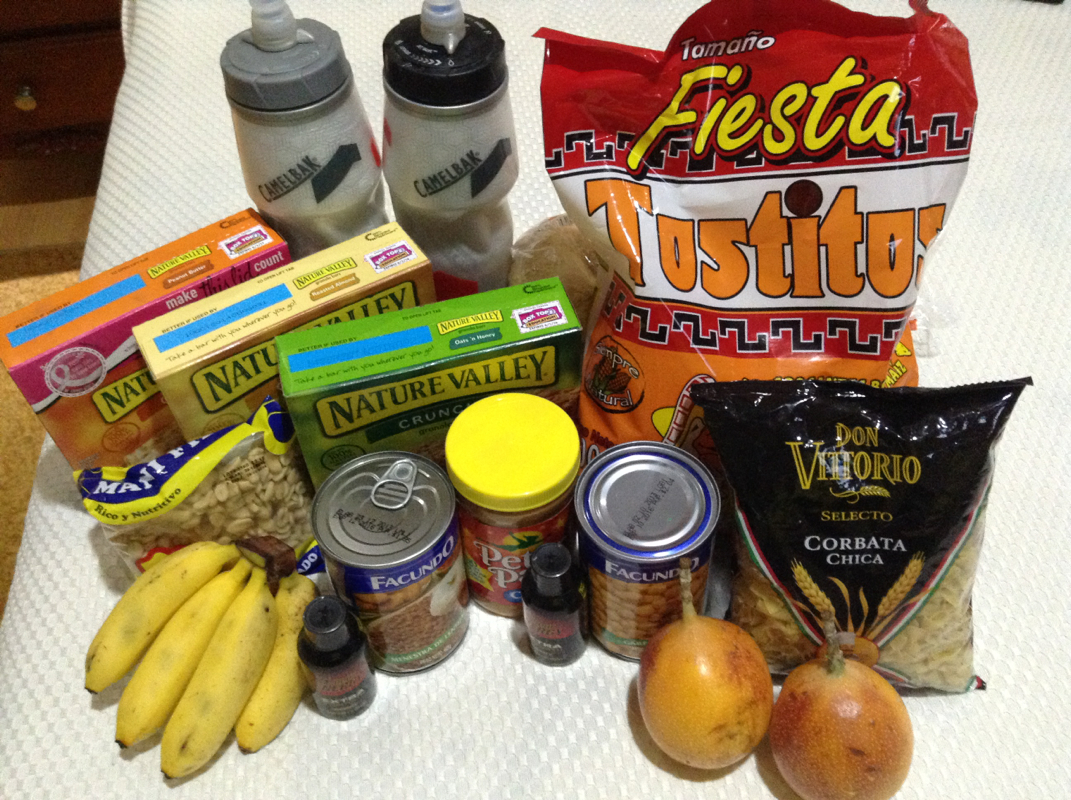
A decent showing of what we like to have in stock to eat. The chips are a definite treat and the cans of beans are heavy, but we have found they are worth it. Ecuadorians don't eat beans like Mexicans and beans are hard to come by in small towns. The orange fruit is a granadilla. Delicious and unique to Ecuador. We eat these when we can!
Quito is a city struggling against it's own topography. The center of town, stretches down a narrow plain, hemmed on one side by steep, volcanic hills, and on the other by tumbling erosion that bottoms out at rivers lying more than 2,000ft below. It seems a curious place for a capital, for as the city expands the bare concrete construction is forced to cling to ever steeper slopes. When we arrived in the northern outskirts, after climbing 2,200ft from a warm night in Guayllabamba, there was still 20 kilometers of surging, fuming city streets to navigate before finding our rented apartment, still on the north end of downtown. Already a week in country we were both still struggling with the altitude and the equatorial sun, intensity magnified in the thin air. Luckily, we didn't have much to do in Quito other than meet Stevens, the jovial, square-faced Colombian that runs the Maximus project. Stevens happened to be in town for a few days, meeting with his Ecuadorian counterparts as they work to raise a rugby team amidst a non-existent disability culture. It's a difficult task, as Xavier (in charge of Maximus's Quito efforts) explained when the took us out to dinner at dark, chic little pub in Quito's restaurant row. "We have about 8 players that come out to practice, but probably only two will actually class into the sport. The others are amputees with too much function. We just can't find people with quadriplegia." "In a city this big, they have to be out there somewhere." I said. "Yes, the are here. Just hidden." Stevens said with a pained look on his face. It's a problem he deals with on a daily basis. "After the hospital they disappear into the city, sometimes hardly ever leave their house. Yes, they're definitely out there, but..." In Latin America, and much of the world, this is the problem. With no infrastructure or culture of empowerment, a traumatic disability often translates into a sentence of life-long dependency, especially for those at the low-end of the function spectrum. People are cared for by their families and never learn the skills, or are able to afford the equipment, that would allow them to function in the world. Anyone who's been involved with wheelchair rugby knows the power of sport to empower independence. It's no different in Ecuador, but even getting people out of the house and to a practice is a monumental challenge. Unfortunately, Xavier didn't have anything going on during our short stay in Quito that would allow us help with the rugby team. We hope there will be plenty more opportunities for that. If nothing else, hopefully our trip can raise the visibility of persons with disabilities throughout this amazing country. Whether it's through newspaper coverage, or the dozens of people everyday who stop ask us where were going and what were doing, many of the who see us probably didn't know it was even possible for someone who uses a wheelchair to pedal a bike. Not that we've been pedaling anywhere quickly since entering Ecuador. Our progress has been strung between topography lines. We're either moving really slow or really fast, but the fast never lasts long enough to make up for the slow. Such is life in the Andes. The scale of the terrain here takes some getting used to. It's a strange thing to be able to pedal your bike between different climates. One day we're riding amongst Mango trees in the Chota Valley and after a big climb the soil was nourishing potatoes and carrots. At sea level, the transition from tropical fruits to root vegetables takes many thousands of miles; here it's compressed to a few thousand feet of elevation. Our climbs are now measured in thousands of feet rather than hundreds. We climbed a little over a thousand feet over 8 or 9 smog choked miles leaving Quito, battling buses and taxi cabs for right of way in the slow lane. After descending back to our starting altitude, we again started climbing and found ourselves exhausted after only 23 miles. Camping in a buggy field behind the truck parking at a gas station would prove our best choice of the stretch between Quito and Riobamba, for the truckers were more interested in sleeping than talking to us. The next day would prove a tough one, for my blood sugars had gone wonky through the night, staying high as I slept. High blood sugars make me have to pee more than normal (in addition to a variety of other physiological problems) and I woke up dehydrated and sluggish. Blood pressure problems ensued and climbing steadily throughout the day, I had one of my worst days of the trip on my bike. 4 hours of pure suffering brought us less than 10 miles down the road, though I felt like I'd done a century. Worse, the exercise and insulin were doing little to lower my blood sugars. Diabetes is something I rarely talk about (either in the blog or with people in general). It's partly because I've had it for so long that it's become a manageable, if annoying, part of my life. It's something I have to deal with, but it's rarely more than peripheral to my day. The other reason is that, for some reason, everybody seems to have an opinion about what I should be doing to manage my diabetes. Even after long years of learning how to adjust insulin to compensate for Paralympic level physical training, or riding a bike for 6-7 hours a day, people often get a confrontational attitude about things I should be doing differently with my diabetes care. Unless you're an elite-level athlete with diabetes and quadriplegia, or my Endocrinologist (Hi Dr. Beard!), I'm not going to listen to your tips about how to better control my blood sugars. Thus, I prefer to keep it private. Anyway, obviously something was wrong and it was wreaking havoc on my physical output. After checking again and finding continued high blood sugars, I switched to new bottles of insulin and waited to see if they'd do the trick. Luckily, after setting up camp in a school yard and cooking dinner over the unleaded flame of our stove, the blood sugars had come down and I went to bed finally feeling back to normal. The next day we kept climbing, another 7 miles or so, straight up above 10,000ft. For the first time since the Baja, I felt really good on my bike. As it seems to go on this trip, Kelly felt like shit. Fortunately, when Kelly feels like shit, I can actually keep up and we moved at more or less our normal pace. Up at the summit, the road rolled gently through a high pine forest and the breeze blew sharp like Portland's east wind in the spring. Riding at speed in chilly weather put a grand smile on my face and even the descent cooperated, shallow enough that we actually covered 30 miles by lunch time. Unfortunately, that afternoon, after covering a South America best 43 miles, we repeated a Mexico mistake and set up camp in a town plaza on a weekend. Lesson learned, again: you cannot sleep in a Latin American town plaza on a weekend! Well you can try. But between car stereo jams and a late-night soccer game where the teenagers kept sending the ball flying into our tent, it wasn't the most restful night. Yes, shithead teenagers suck, but as our grand political orator G.W. once said: "fool me once, shame on — shame on you. Fool me — you can't get fooled again." Anyways, hopefully we won't get fooled by a peaceful looking town plaza again. We beat a retreat at sunrise and descended into the sprawling, grimy town of Ambato, only to have to climb out of the river gorge it straddles, up probably the steepest hills of the trip so far. Climbing is one thing when you're in the mountains, with clear air and sumptuous views, quite another when it's accompanied by fumes, Ferreterias (repair shops), and gawking townies. Seeing our stop/start struggling, some local good samaritans came to push us both up a particularly nasty stretch. We must've looked like shit because one of them offered us some breakfast and a shower at his house. We wound up setting up camp on the Rios family's 3rd floor terrace because we felt as bad as we looked. Soon the family was offering to drive us to visit Baños because we wouldn't be passing through there on our route, and "it's beautiful and there are lots of foreigners!" An hour later we were packed three wide into the family sedan, sucking on granadilla and zapoto (an orange-fleshed fruit, stringy like a squash with a mildly pleasing sweetness, messy like the juiciest mango, which is best eaten anywhere other than the cramped backseat of a Nissan), and descending out of the central highlands towards the Amazon Basin. Baños has the hostal/pub/tour operator uniformity of backpacker towns worldwide and after some lovely sightseeing, we were eager to get back to our terrace and rest our tightening bodies. The Rios family, however, was out to make sure we got the full orient of Ecuador experience. Our jaunt down the road soon turned into a 9 hour expedition, descending farther and farther into the thickening rain forest, visiting family friends, property shopping, sucking the meat off whole Tilapia, us wondering at every stop: maybe, just maybe are we going to turn around yet? This is probably a good time to expound on Ecuadorian hospitality, which is both wonderful and indescribably maddening. The Ecuadorians we've met so far have been incredibly friendly and generous, offering us refreshments, places to camp, bags of fruit, bottles of water, and genuine interest in our trip, all as we pedal down the road. They, however, have been entirely disinclined to take no for an answer. Politely refusing a large bag of grapefruits, plums, or pears, explaining that: A. We have no more space on our overloaded bikes to strap 5 pounds of fruit. B. 5 pounds is a lot of weight when you're pedaling up the side of a mountain. C. We won't possibly be able to eat all 5 pounds of fruit before it goes bad, or is bruised to shit because, you know, it'll be jiggling down the road on top of a bicycle. Is usually greeted by a smile and: "No, no, no, you need this fruit, just take the fruit." Similar scenes occur when chatting with people on the side of the road and trying to explain that we need to get moving. "Oh you need to keep riding, okay...but I have a brother, and he doesn't ride bicycles, but he has a motorcycle and he once took a trip to Peru, have you been to Peru yet?..." Or getting ready for bed and explaining that we need to get more than 6 hours of sleep if we're going to make any distance the next day. "Oh, I bet your very tired, but are you sure you don't want a cup of tea, it's quite tasty. No? Okay, yes, you must be tired. Say, this is a very nice looking tent, is it warm? Are you sure you won't get wet if it rains? It's very cold out right now, are you sure you don't want a cup of tea?" All of this is exactly what traveling is all about, cultural differences and the like. For a large majority of the people in the countries we're traveling through don't really understand the need for privacy, personal space, and peace and quiet, which are primarily northern constructs. But when you've ridden your bike for 60 kilometers through the spine of the Andes and all you want is a quiet patch of grass to cook dinner and lay your weary body, all these little differences can make you want to tear your hair out and pretend you forgot how to speak Spanish. All part of the journey though, right? Which brings us back to our expedition with the Rios family. Where, after 8 hours of driving around we now found ourselves at the Baños thermal baths, which we'd already explained we didn't have much interest in, but papa Rios had decided that it would be good if we just stopped by and he'd see if we could elbow our way past the waiting throngs so that we could just go in and see the pools, which are really quite famous, don't you know? As I was about to start banging my head into the window, Mother Nature intervened by way of Mt. Tungurahua, which had started erupting only a few miles away from Baños. Papa Rios, to our infinite delight, decided it would be prudent if we headed back up to Ambato. On the way up, we rounded a bend and spied a line of cars pulled off the road with their blinkers flashing and their occupants on the grass marveling at the sky behind us. We pulled over and less than a minute later the black sky lit with specks of red, lava burst into the sky and then roiled down the upper peak. "Holy balls!" I exclaimed. Definitely one of the most surprising, and awe-inspiring moments of my life. Which is how this trip seems to be going, just when we start to get grumpy and annoyed with everyone, something grand enough happens that makes us step back and marvel. So eventually we did make it away from the overly hospitable Rios family, but not before mama Rios decided to gift me a half-used bottle of foot-cream. The next morning we started climbing up towards the highest mountain in Ecuador, Mt. Chimborazo, which crests at a snow-covered 20,500ft. We knew we'd not make it up to the 12,000ft road summit in one day, so after a few steep hours we saw a sign for a roadside inn and decided to pay $30 for the privacy that a locking door affords. After a solid night of sleep, both Kelly and I felt revived and we rocked out to Biggie Smalls and Jay Z as we packed our bikes. The climbing started as we'd left it, steep and unending, but after warming up we both felt good on our bikes. Grinding up hills, with patchwork fields and cloud laden hills following us the whole way, it felt good to be pushing my body and having it respond like I know it can. Another 18 kilometers up, and we crested into a misty, wind swept landscape where a lusty bull was attempting to mount his bovine desire and, sadly, striking only air. A few kilometers later, unable to have seen the snowy peak of Chimborazo because of the heavy clouds, we started back down the mountain. The road was smooth and the curves gentle. I opened it up and flew past Kelly, the thin air offering little resistance and soon topped out at 49mph, blurring by Fedora-clad locals who laughed at our speed as we passed. For 10 miles we barely dipped below 40mph. By the time we reached the pueblo of San Andres, I was giddy with endorphins, trembling with adrenalin. We only had another 8 miles to the promise of a rest and some quality food in Riobamba. I said it then and I can confirm now that I've never had a better day on a bike. |